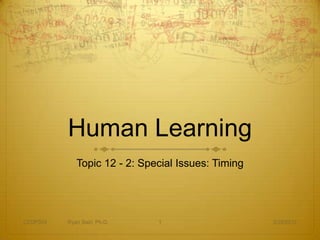324 12 2 special topics timing
•Download as PPTX, PDF•
0 likes•280 views
Report
Share
Report
Share

Recommended
Recommended
More Related Content
Viewers also liked
Viewers also liked (10)
324 02 part 1 elicited behavior, habituation, sensitization

324 02 part 1 elicited behavior, habituation, sensitization
324 02 part 3 elicited behavior, habituation, sensitization

324 02 part 3 elicited behavior, habituation, sensitization
Facilitating Complexity: A Pervert's Guide to Exploration

Facilitating Complexity: A Pervert's Guide to Exploration
More from Ryan Sain
More from Ryan Sain (19)
Recently uploaded
Recently uploaded (20)
Exploring the Future Potential of AI-Enabled Smartphone Processors

Exploring the Future Potential of AI-Enabled Smartphone Processors
Finding Java's Hidden Performance Traps @ DevoxxUK 2024

Finding Java's Hidden Performance Traps @ DevoxxUK 2024
Connector Corner: Accelerate revenue generation using UiPath API-centric busi...

Connector Corner: Accelerate revenue generation using UiPath API-centric busi...
Apidays New York 2024 - The value of a flexible API Management solution for O...

Apidays New York 2024 - The value of a flexible API Management solution for O...
Why Teams call analytics are critical to your entire business

Why Teams call analytics are critical to your entire business
How to Troubleshoot Apps for the Modern Connected Worker

How to Troubleshoot Apps for the Modern Connected Worker
Apidays New York 2024 - Scaling API-first by Ian Reasor and Radu Cotescu, Adobe

Apidays New York 2024 - Scaling API-first by Ian Reasor and Radu Cotescu, Adobe
Repurposing LNG terminals for Hydrogen Ammonia: Feasibility and Cost Saving

Repurposing LNG terminals for Hydrogen Ammonia: Feasibility and Cost Saving
Axa Assurance Maroc - Insurer Innovation Award 2024

Axa Assurance Maroc - Insurer Innovation Award 2024
Apidays New York 2024 - Passkeys: Developing APIs to enable passwordless auth...

Apidays New York 2024 - Passkeys: Developing APIs to enable passwordless auth...
Navigating the Deluge_ Dubai Floods and the Resilience of Dubai International...

Navigating the Deluge_ Dubai Floods and the Resilience of Dubai International...
"I see eyes in my soup": How Delivery Hero implemented the safety system for ...

"I see eyes in my soup": How Delivery Hero implemented the safety system for ...
Apidays New York 2024 - APIs in 2030: The Risk of Technological Sleepwalk by ...

Apidays New York 2024 - APIs in 2030: The Risk of Technological Sleepwalk by ...
324 12 2 special topics timing
- 1. Human Learning Topic 12 - 2: Special Issues: Timing CEDP324 Ryan Sain, Ph.D. 1 3/29/2012
- 2. What is timing? Effects of stimuli are determined by durations or distributions in time Identifying that time has passed – and responding in a different manner Habituation, sensitization, spontaneous recovery Classical conditioning Operant conditioning CEDP324 Ryan Sain, Ph.D. 2 3/29/2012
- 3. Studying timing Timing as a biological process Environmental clues must be ruled out Clocks ticking Sun rising CEDP324 Ryan Sain, Ph.D. 3 3/29/2012
- 4. Timing techniques Duration estimation Discrimination task Sd is the duration of an event Match to sample procedure Peak procedure Sd presented After specified time passes a response will produce Sr Responding follows a generalization gradient CEDP324 Ryan Sain, Ph.D. 4 3/29/2012
- 5. Time out! Using a peak procedure 20 second peak 10 second delay 20 second No delay Introduce a break in the Sd 10 seconds Sd only presented for 20 seconds total 10 20 30 40 The peak shifts by that amount of break CEDP324 Ryan Sain, Ph.D. 5 3/29/2012
- 6. Theories Cognitive – Scalar Expectancy Theory Pacemaker Switch accumulator (sums) Send that info to working memory Then compare that to the stimulus and decide if you should respond Behavioral Adjunctive behavior (waiting behaviors) Finger tapping, etc Those occur in a particular pattern After the pattern is complete the interval should be over CEDP324 Ryan Sain, Ph.D. 6 3/29/2012
